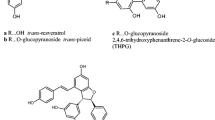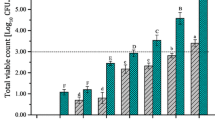Abstract
Physical parameters, such as particle size distribution, flow behavior, density, turbidity, and color, were measured and sensory evaluation was carried out to compare the properties of freshly squeezed grapefruit juice with those of juice that has been pasteurized by microwave or by following a conventional heating method. Samples were either frozen-stored or refrigerated. In general, the physical parameters of grapefruit juice were significantly affected by heat treatment, especially in the case of the conventional process. However, from a sensory point of view, pasteurized samples were similar to fresh ones. When frozen, turbidity, particle size distribution, density, flow behavior, and color were stable throughout the studied period, regardless of the pasteurization treatment. During refrigerated storage, the turbidity, particle size distribution, and consistency index decrease. This occurs in a more pronounced way in the case of juice which has not been submitted to a heating treatment, probably due to residual pectin methyl esterase activity. Furthermore, the association between the carboxyl groups of pectin chains and Ca2+ could be responsible for both the subsequent increase in the turbidity of the juice and also the decrease in its density. Throughout the period under study, the smallest color change was experienced by microwave-pasteurized juice. For these reasons, and also due to the reduction in the process time, microwave treatment can be recommended as a method for the pasteurization of grapefruit juice.










Similar content being viewed by others
References
AENOR. (2008). Sensory analysis: vocabulary. UNE-EN-ISO 5492. Madrid, Spain: AENOR.
AENOR. (2009a). Particle size analysis—laser diffraction methods. ISO 13320:2009. Madrid, Spain: AENOR.
AENOR. (2009b). Sensory analysis: methodology. Paired comparison test. UNE-EN-ISO 5495. Madrid, Spain: AENOR.
Astigarraga-Urquiza, J., & Astigarraga-Aguirre, J. (1995). Hornos de alta frecuencia y microondas: teoría, cálculo y aplicaciones. Madrid, Spain: McGraw-Hill.
Baker, R. A., & Cameron, R. G. (1999). Clouds of citrus juices and juice drinks. Food Technology, 53, 64–69.
Barnavon, L., Doco, T., Terrier, N., Agearges, A., Romieu, C., & Pellerin, P. (2001). Involvement of pectin methylesterase during the ripening of grape berries: partial cDNA isolation, transcript expression and changes in the degree of methyl-esterification of cell wall pectins. Phytochemistry, 58, 693–701.
Bodart, M., Peñaranda, R., Deneyerc, A., & Flamant, G. (2008). Photometry and colorimetry characterization of materials in daylighting evaluation tools. Building and Environment, 43, 2046–2058.
Cañumir, J. A., Celis, J. E., Brujin, J., & Vidal, L. (2002). Pasteurisation of apple juice using microwaves. Lebensmittel-Wissenschaft und Technologie, 35, 389–392.
Chandler, B. U., & Robertson, G. L. (1983). Effect of pectic enzymes on cloud stability and soluble limonin concentration in stored orange juice. Journal of the Science of Food and Agriculture, 34, 599–611.
Clemente, E. (1998). Purification and thermostability of isoperoxidase from orange. Phytochemistry, 49, 26–29.
Corredig, M., Kerr, W., & Wicker, L. (2001). Particle size distribution of orange juice cloud after addition of sensitized pectin. Journal of Agriculture of Food Chemistry, 49, 2523–2526.
Elez-Martínez, P., Aguiló-Aguayo, I., & Martín Belloso, O. (2006). Inactivation of orange juice peroxidase by high-intensity pulsed electric fields as influenced by process parameters. Journal of the Science of Food and Agriculture, 86, 71–81.
Farnworth, E. R., Lagacea, M., Couture, R., Yaylayan, V., & Stewart, B. (2001). Thermal processing, storage conditions and the composition and physical properties of orange juice. Food Research International, 34, 25–30.
Gross, M. D., & Moser, J. B. (1977). A colorimetric study of coffee and tea staining of composite resins. Journal of Oral Rehabilitation, 4, 311–322.
Igual, M., García-Martínez, E., Camacho, M. M., & Martínez-Navarrete, N. (2010). Effect of thermal treatment and storage on the stability of organic acids and the functional value of grapefruit juice. Food Chemistry, 118, 291–299.
Igual, M., García-Martínez, E., Camacho, M. M., & Martínez-Navarrete, N. (2013). Physicochemical and sensorial properties of grapefruit jams as affected by processing of grapefruit juice. Food and Bioprocess Technology, 6, 277–185.
Johnston, W. M., & Kao, E. C. (1989). Assessment of appearance match by visual observation and clinical colorimetry. Journal of Dental Research, 68, 819–822.
Joslyn, M. A., & Pilnik, W. (1961). Enzymes and enzyme activity. In W. B. Sinclair (Ed.), The orange: its biochemistry and physiology (pp. 373–435). Berkeley, CA: University of California Press.
Kimball, D. A. (1999). Procesado de cítricos (2nd ed.). Zaragoza, Spain: Acribia.
Klavons, J. A., Bennett, R. D., & Vannier, S. H. (1994). Physical/chemical nature of pectin associated with commercial orange juice cloud. Journal of Food Science, 59, 399–401.
Lee, H. S., & Coates, G. A. (1999). Thermal pasteurization effects on color of red grapefruit juices. Journal of Food Science, 64(4), 663–666.
Lee, H. S., & Coates, G. A. (2002). Characterization of color fade during frozen storage of red grapefruit juice concentrates. Journal of Agricultural and Food Chemistry, 50, 3988–3991.
Martín-Diana, A. B., Rico, D., Barat, J. M., & Barry-Ryan, C. (2009). Orange juices enriched with chitosan: optimisation for extending the shelf-life. Innovative Food Science and Emerging Technologies, 10, 590–600.
Meilgaard, M., Civille, G. V., & Carr, B. T. (1999). Attribute differences test. Pairwise ranking test: Friedman analysis. In M. Meilgaard, G. V. Civille, & B. T. Carr (Eds.), Sensory evaluation techniques (3rd ed., pp. 103–106). London: CRC.
Nicolau, K., Andrey, J., Vitoriano, P., & Cecilia, C. (2008). Inactivation kinetics of polyphenol oxidase and peroxidase in green coconut water by microwave processing. Journal of Food Engineering, 88, 69–176.
Nikdel, S., Chen, C., Parish, M., MacKellar, D., & Friedrich, L. (1993). Pasteurization of citrus juice with microwaves energy in a continuous-flow unit. Journal of Agricultural and Food Chemistry, 41, 2116–2119.
Pankaj, B. P., Umezuruike, L. O., & Fahad, A. A. (2013). Colour measurement and analysis in fresh and processed foods: a review. Food and Bioprocess Technology, 6, 36–60.
Scardina, P. (2009). Fruit juices: properties, consumption and nutrition. Food and beverage consumption and health series. New York: Nova Science Publishers.
Shim, S. M., & Kim, G. H. (2002). Color changes and carotenoid pigment loss in retentate from star ruby grapefruit juice under refrigerated conditions. Food Science and Technology Research, 8(3), 244–246.
Steffe, J. F. (1996). Rheological methods in food process engineering (2nd ed.). East Lansing, MI: Freeman Press.
Tang, J. (2005). Dielectric properties of foods. In H. Schubert & M. Regier (Eds.), The microwave processing of foods (pp. 22–38). Cambridge: Woodhead Publishing.
Taylor, B. (2005). Fruit and juice processing. In P. R. Ashurst (Ed.), Chemistry and technology of soft drinks and fruit juices (2nd ed., pp. 35–67). Oxford, UK: Blackwell.
Varnam, A. H., & Sutherland, J. P. (1999). Fruit juices. In A. H. Varnam & J. P. Sutherland (Eds.), Beverage: technology, chemistry and microbiology: vol. 2. Food products series (pp. 26–72). New York: Aspen Publications.
Venkatesh, M. S., & Raghavan, G. S. V. (2004). An overview of microwave processing and dielectric properties of agri-food materials. Biosystems Engineering, 88, 1–18.
Vikram, V. B., Ramesh, M. N., & Prapulla, S. G. (2005). Thermal degradation kinetics of nutrients in orange juice heated by electromagnetic and conventional methods. Journal of Food Engineering, 69, 31–40.
Zvaigzne, G., & Karklina, D. (2009). Antioxidants in various citrus fruit juices. Chemine Technologija, 3(52), 56–61.
Author information
Authors and Affiliations
Corresponding author
Rights and permissions
About this article
Cite this article
Igual, M., Contreras, C., Camacho, M.M. et al. Effect of Thermal Treatment and Storage Conditions on the Physical and Sensory Properties of Grapefruit Juice. Food Bioprocess Technol 7, 191–203 (2014). https://doi.org/10.1007/s11947-013-1088-6
Received:
Accepted:
Published:
Issue Date:
DOI: https://doi.org/10.1007/s11947-013-1088-6




